|
|
|
Pancho Villa Raids Columbus circa 1916
|
In the early
spring of 1916, Columbus was a sleepy little
border town. As the Mexican Revolution raged to
the south, most Americans perceived little
threat from this conflict, including many of
Columbus' citizens, who felt safe in their
village. |
|
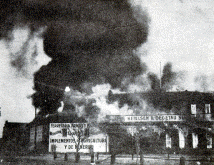
The Columbus
Raid |
|
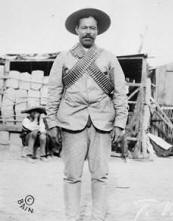
Pancho Villa
|
|
To add to this
feeling of security, a detachment of
approximately 350 U.S. Army soldiers from the
13th Calvary stationed at Camp Furlong on the
outskirts of Columbus stood between Mexico and
the town. The early morning of March 9, 1916,
life in Columbus changed dramatically. At 1:00
A.M., between 500 and 600 Mexican
revolutionaries, led by General Francisco "Pancho"
Villa, crossed the border into the United
States. Villa divided his troops and attacked
Columbus from the southwest at approximately
4:20 am. This attack caught the entire town, as
well as the army camp, by surprise. |
|
The Villistas
concerned themselves more with raiding than
killing, otherwise the town might have been
erased. That morning majority of the destruction
of the town came from the burning and pillaging
of the business district. Surprisingly, the army
camp and stables received little damage, even
though the horses and armaments must have been
attractive to the raiders. |
|
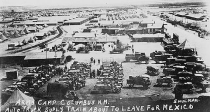
Old Camp Furlong |
|
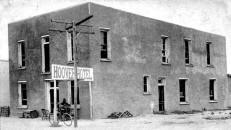
Original Hoover Hotel
|
|
Alerted by the
gunfire and burning buildings, many Columbus
residents fled to the desert, or sought refuge
in the school house, the Hoover Hotel, or
private homes. U.S. Army officers and soldiers,
awakened by the commotion, set up a
Benet-Mercier machine gun in front of the Hoover
Hotel and produced a murderous rain of bullets.
|
|
|
Another machine
gun set up on East Boundary Street fired north
and caught anyone in the intersection of
Broadway and East Boundary in a deadly
crossfire. The raid lasted until dawn, or
approximately one and a half hours. By this
time, the death toll totaled 70 to 75 Villistas.
In addition, during the attack on Columbus
eighteen Americans, mostly civilians, died. Much
speculation abounds concerning General Villa's
motivation behind the Columbus raid. One theory
suggests it was an act of retaliation. Embroiled
in a civil war, Mexico searched for leadership.
A dispute broke out between Pancho Villa and
Venustiano Carranza when Villa refused to
acknowledge the authority of the new president,
Carranza. To add insult to injury, President
Wilson aided Carranza by allowing Mexican troops
to be transported on the El Paso- Southwestern
Railroad through Texas and New Mexico to a
campaign in Mexico. These troops helped defeat
Villa and his army in a revolutionary battle.
Possibly the attack on Columbus occurred as
retaliation for the shipment of troops, since
the village had an El Paso - Southwestern depot.
Amazingly enough however, the depot only
sustained light damage from flying bullets. |
|
After The
Raid
Columbus, NM
March 9, 1916 |
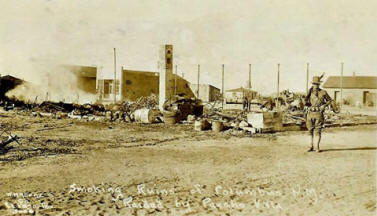 |
Looking at where and what the Villistas raided,
historians have pointed out that little beyond the
business district of Columbus received any real damage.
Perhaps Villa raided Columbus to correct a business deal
gone bad. This theory contends that Villa bought guns
and ammunition from the Ravel Brothers of Columbus.
Although he paid for the armaments, Villa never received
the weapons and ammunition. During the raid, Villistas
captured Arthur Ravel and tried to force him to open the
business's safe. Fortunately, the Villistas believed
Ravel, when he stated he did not know the combination.
Arthur Ravel eventually escaped the Villistas when
gunfire, possibly from the machine gun in front of the
Hoover Hotel, killed the two men holding his arms.
Whatever the reasons for the attack, its outcome was the
same. Columbus residents experienced a boom in their
village. General John J. "Black Jack" Pershing arrived
in Columbus to lead a punitive expedition into Mexico to
find and capture Pancho Villa. Columbus became the home
base of this expedition and a beehive of activity. By
March 10, just one day after the raid, the first of
several thousand troops began to arrive in Columbus. By
late 1916, due to the growth of camp personnel, Columbus
held the largest population of any city in the state of
New Mexico.
|
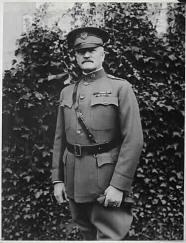
General Pershing
|
|
Several thousand
troops, at times going 300 miles into Mexico,
were supported by trucks and airplanes, the
first such aid in American warfare. Indeed, the
punitive expedition saw the end of
nineteenth-century warfare and the beginning of
twentieth-century combat. The 1st Aero Squadron
was moved to Columbus and soon became the first
Air Force contingency to be used in a foreign
campaign. Motorized vehicles, including armored
cars were also tried out in Columbus. George
Patton, serving under General Pershing took
command of the motorized fleet with raids into
the Mexico borderlands. The Punitive expedition
became a testing zone for all forms of war
craft, and officer training in preparation for
WW1.
|
|

Motorized Armored Car |
|
After the Punitive
expedition, Columbus began making changes that
would last for decades. Initially, Camp Furlong
remained in operation by the Army, but at a
decreased level of activity. Toward the end of
the 1926, the Department of Army decided that a
military detachment was no longer needed in
Columbus. The El Paso & Southwest Railroad
stopped service to Columbus as well.
|
With
these decisions, the notoriety and economic strength
that Columbus had enjoyed was in a steady decline. Since
the mid 1990's Columbus has been on an upsurge again.
The advent of the R.V. lifestyle reinvigorated Columbus'
position on the map. With a State Park, museums, a
border crossing, and rich historical value, Columbus
became a natural stopping point. Many occasional
travelers retired in Columbus, finding the low cost of
living, and high quality of life to be very attractive.
|
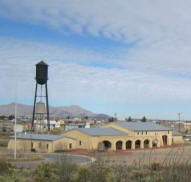
State Park Museum |
|
Perhaps the
biggest boon to America re-discovering Columbus
came as a result of the 9/11 attacks. This
tragedy renewed interest on Columbus which had
previously stood as the only place America had
experienced a foreign invasion.
|
Click
to visit our page sponsor:
|